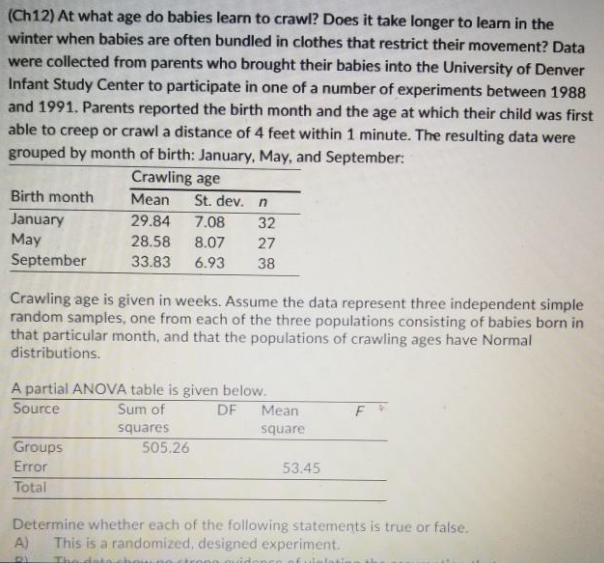Determine whether each of the following statements is true or false. This is a randomized, designed experiment. A) B) The data show no strong evidence of violating the assumption that the three populations have the same standard deviation. C) An ANOVA cannot be used on these data because the sample sizes are different. An ANOVA cannot be used on these data because the data show D) very strong evidence of non-Normal population distributions.
Determine whether each of the following statements is true or false. This is a randomized, designed experiment. A) B) The data show no strong evidence of violating the assumption that the three populations have the same standard deviation. C) An ANOVA cannot be used on these data because the sample sizes are different. An ANOVA cannot be used on these data because the data show D) very strong evidence of non-Normal population distributions.
Algebra & Trigonometry with Analytic Geometry
13th Edition
ISBN:9781133382119
Author:Swokowski
Publisher:Swokowski
Chapter5: Inverse, Exponential, And Logarithmic Functions
Section5.6: Exponential And Logarithmic Equations
Problem 64E
Related questions
Topic Video
Question

Transcribed Image Text:(Ch12) At what age do babies learn to crawl? Does it take longer to learn in the
winter when babies are often bundled in clothes that restrict their movement? Data
were collected from parents who brought their babies into the University of Denver
Infant Study Center to participate in one of a number of experiments between 1988
and 1991. Parents reported the birth month and the age at which their child was first
able to creep or crawl a distance of 4 feet within 1 minute. The resulting data were
grouped by month of birth: January, May, and September:
Crawling age
Birth month
Mean
St. dev. n
January
29.84
7.08
32
May
September
28.58
8.07
27
33.83
6.93
38
Crawling age is given in weeks. Assume the data represent three independent simple
random samples, one from each of the three populations consisting of babies born in
that particular month, and that the populations of crawling ages have Normal
distributions.
A partial ANOVA table is given below.
DF
Source
Sum of
Mean
squares
505.26
square
Groups
Error
53.45
Total
Determine whether each of the following statements is true or false.
A)
This is a randomized, designed experiment.
The date

Transcribed Image Text:Determine whether each of the following statements is true or false.
A)
This is a randomized, designed experiment.
The data show no strong evidence of violating the assumption that
the three populations have the same standard deviation.
An ANOVA cannot be used on these data because the sample sizes
B)
C)
are different.
D)
An ANOVA cannot be used on these data because the data show
very strong evidence of non-Normal population distributions.
Expert Solution
This question has been solved!
Explore an expertly crafted, step-by-step solution for a thorough understanding of key concepts.
Step by step
Solved in 2 steps

Knowledge Booster
Learn more about
Need a deep-dive on the concept behind this application? Look no further. Learn more about this topic, statistics and related others by exploring similar questions and additional content below.Recommended textbooks for you

Algebra & Trigonometry with Analytic Geometry
Algebra
ISBN:
9781133382119
Author:
Swokowski
Publisher:
Cengage

Algebra: Structure And Method, Book 1
Algebra
ISBN:
9780395977224
Author:
Richard G. Brown, Mary P. Dolciani, Robert H. Sorgenfrey, William L. Cole
Publisher:
McDougal Littell

Trigonometry (MindTap Course List)
Trigonometry
ISBN:
9781337278461
Author:
Ron Larson
Publisher:
Cengage Learning

Algebra & Trigonometry with Analytic Geometry
Algebra
ISBN:
9781133382119
Author:
Swokowski
Publisher:
Cengage

Algebra: Structure And Method, Book 1
Algebra
ISBN:
9780395977224
Author:
Richard G. Brown, Mary P. Dolciani, Robert H. Sorgenfrey, William L. Cole
Publisher:
McDougal Littell

Trigonometry (MindTap Course List)
Trigonometry
ISBN:
9781337278461
Author:
Ron Larson
Publisher:
Cengage Learning